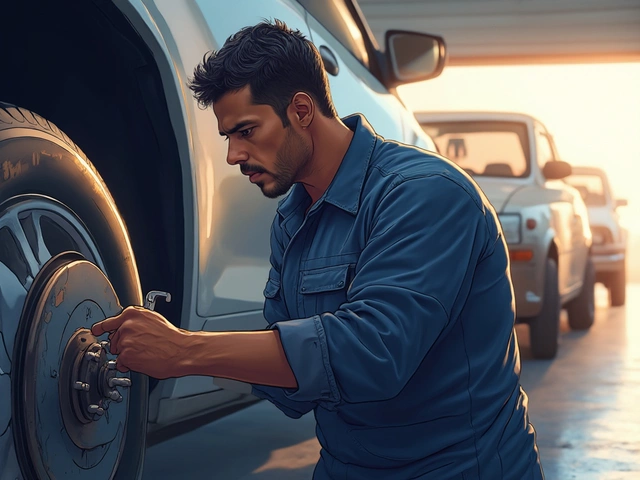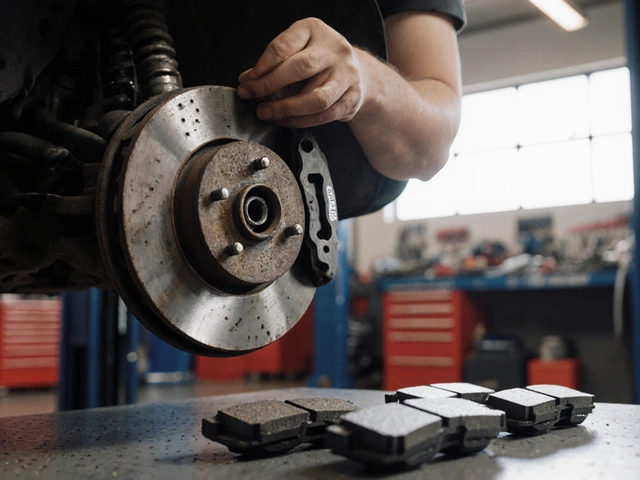
Spotting a bent suspension doesn’t take a mechanic’s eye if you know what to look for. Maybe your car suddenly pulls to one side, or your steering wheel isn’t straight anymore. Notice one tire wearing faster than the rest? That’s often the first red flag.
Don’t shrug off weird handling or knocking sounds after you’ve hit a curb or crater-sized pothole. I’ve seen people spend way more on tires and alignments because they missed these early signs. A little vigilance now saves you a heap of trouble later.
Even if everything looks fine, a quick walk-around inspection can reveal more than you think. Check the gaps between tires and fenders—they should all match. Got one corner sitting lower? Something could be bent underneath.
- Why Bent Suspension Is a Big Deal
- Most Common Ways Suspension Gets Bent
- Obvious Signs Your Suspension Is Off
- How to Double-Check at Home
- Unusual Symptoms Most People Miss
- Need-to-Know Repair Tips
Why Bent Suspension Is a Big Deal
Driving around with a bent suspension does more than make your ride bumpy or noisy. It throws off your whole car’s balance and handling, making everything less predictable—even dangerous. If something’s bent down there, your car will struggle to grip the road like it should, especially when you’re braking hard or cornering at speed. That can turn a normal commute into a close call.
Forget just comfort—bent suspension parts can also kill your tires faster than you'd think. Ever seen tire wear on one edge but nowhere else? That’s usually from bad alignment, often tied back to bent control arms or struts. The AAA says,
"Misaligned suspension systems can reduce tire life by up to 50%—and increase your stopping distance, especially on wet roads."
Besides the tire headache, you’re risking way bigger repair bills if you keep ignoring these problems. A bent part leads to more stress on everything else, like bushings and ball joints. That means what started as a minor fix can snowball into a list of expensive parts.
- Steering problems: Bent pieces can throw your alignment out of whack, making your car pull or your steering wheel crooked.
- Extra strain: Everything works harder and wears out faster, from the sway bars to the shocks.
- Safety risks: Slower stopping, worse control, and the chance of something snapping at the worst possible time.
If you factor in the cost of an average new tire (around $150 each in the U.S.) and a fresh alignment (another $100+), you’ll see how ignoring a bent suspension can get pricey fast.
Most Common Ways Suspension Gets Bent
It’s actually easier than you’d think to end up with a bent suspension. The most straightforward cause is any kind of serious impact. Hit a deep pothole faster than you should? That’ll do it. Whack the curb while taking a sharp turn or misjudge a parking spot by even a few inches—yep, your car suspension could be at risk. You don’t have to get into a fender bender to mess things up underneath.
Here's a quick rundown of what puts your suspension in the danger zone:
- Potholes: Even one big hit can knock things out of whack. Studies show urban drivers hit an average of two bad potholes per month.
- Curb strikes: It only takes one decent smack, especially at higher speeds, to bend control arms or struts.
- Speed bumps: Going too fast over those "traffic calming" lumps is a silent killer for suspension parts. Bent components aren’t rare as a result.
- Off-road adventures: If your car wasn’t built for rough trails, save your suspension the pain. Rocks and dips put extra pressure in all the wrong places.
- Accidents: Even low-speed collisions jam way more force into your wheels and suspension than you might think.
Here’s how the damage stacks up from common impact types:
| Cause | Chance of Bending | Parts Most Affected |
|---|---|---|
| Potholes | High | Control arms, tie rods, wheels |
| Curb strikes | Medium to High | Struts, steering knuckles |
| Speed bumps (hit fast) | Medium | Shocks, sway bars |
| Accidents | Very High | All major suspension parts |
No matter how careful you are, sometimes stuff happens. Just knowing these troublemakers means you can keep an eye out and avoid expensive headaches down the road.
Obvious Signs Your Suspension Is Off
You don't need X-ray vision to spot a bent suspension. The warning signs are right there if you know what to look for. The first thing many notice is the car starting to pull to one side, even if you’re driving on a flat, straight road. If your steering problems kick in—like the wheel doesn’t center after a turn, or it just feels weird—that’s another big clue.
One of the most common giveaways is uneven tire wear. If one tire goes bald faster than the others, or the tread looks choppy, your car suspension could be buggered. Quick tip: run your palm across the tread. Feel any rough or bumpy patches? That’s not normal and probably not just a tire issue.
A car that sits unevenly, like it’s got a saggy corner or rides lower than you remember, probably has something bent underneath. Sometimes you’ll even spot a visible tilt if you step back and eyeball your car from a distance. And if you hear new clunks or knocks from under the car, those noises aren’t your imagination—they're classic signs of a suspension problem.
- Steering wheel isn’t centered or the car pulls in one direction
- Weird noises like popping, clunking, or rattling—especially over bumps
- One wheel sits closer or farther from the fender than the rest
- Car sits low or sags on a corner
- Really bad handling—car sways more, feels loose, or you lose grip on turns
If you spot more than one of these issues at once, don’t wait. Things only get worse (and more expensive) if you ignore them. Shops report that most suspension fixes come from people who waited until tire damage or poor handling nearly caused a crash. Staying alert to these obvious signs could save you a world of hassle and some serious cash down the road.

How to Double-Check at Home
You don’t need a fancy lift or a wall covered in tools to do a simple bent suspension check at home. In fact, most folks can spot the basics with a flashlight, a tape measure, and a careful eye.
- Park on Level Ground: Make sure your car is on flat pavement. Any slope can throw off what you’re about to see.
- Eye Your Ride Height: Walk around your car and check the space between each tire and the fender. Are they even? If one side sags or sits higher, that’s suspicious.
- Check the Tire-to-Fender Gap (Tape Measure Trick): Measure from the ground to the bottom of the fender at all four corners. Differences over half an inch can signal a problem with your suspension.
- Look at the Tires: A bent suspension usually messes up wheel alignment. If you see odd tire wear—like more tread loss on one edge or a scrappy, feathered pattern—it’s time to dig deeper.
- Inspect the Wheels: Step behind the car a few feet and sight down the tires. If one points in or out (that’s called toe-in or toe-out), alignment is off, often because of a bent suspension part.
- Listen and Feel: Take it for a short drive around the block. Listen for new clunks or rattles and pay attention to any wobbly steering. If your car suspension is bent, you’ll feel extra vibration or a pull in the steering wheel.
Here’s an easy way to compare your results if you want to be extra sure:
| Check | Normal Result | Warning Sign |
|---|---|---|
| Tire-to-Fender Gap | Same on both sides | One gap bigger or smaller |
| Tire Wear | Even across tread | Extra wear inside or outside edge |
| Steering Wheel | Points straight | Off-center when driving straight |
You don’t need to diagnose the exact part that’s bent, but these steps will help you know if something’s not right. If you find one of these issues, it’s time to get a pro involved before it spirals into a bigger, more expensive problem.
Unusual Symptoms Most People Miss
Some clues that your bent suspension is causing trouble aren’t obvious, and a lot of drivers blow right past them. For example, weird vibrations that come and go—especially if they kick in after hitting bumps or when you’re making a slow turn—are often overlooked. These aren’t the regular road buzz or shaky wheels from cheap tires. They’re a sign something’s bent or knocked out of alignment.
Another sneaky sign is uneven ride height. If your car looks like it’s sagging on one corner, it might not just be an old spring. Bent suspension arms or struts can drop one side lower, messing up both comfort and handling. Here’s a super quick check: Park on flat ground and use a measuring tape to see if the gaps above each tire match up. Even a small difference can point to something bent.
Strange noises can tell you plenty. Ever hear a metallic clunk or squeak when braking or over speed bumps? That’s not just age; it’s often a result of car suspension parts fighting an unnatural angle. Don’t just crank up your radio and ignore it.
- Steering feels numb – If you notice “play” in the steering wheel, especially if the car briefly resists turning before snapping into line, it’s not normal wear. Bent components change how steering input is transmitted.
- ABS or traction control warnings – A bent suspension can cause wheel sensors to get weird readings, lighting up your dashboard even if brakes feel fine.
- Flaky alignment – Got your alignment checked, but the car’s still all over the place a week later? Bent parts make it impossible to keep things straight.
Bent parts put extra stress on mounts, bushings, and joints, leading to problems months down the road. According to a 2023 insurance claims report, about 15% of cars that ran over major potholes ended up with suspension damage that didn’t get caught until later. People thought the issue was just their tires or alignment and kept driving until bigger problems showed up.
Keep an eye (and ear) out for these less obvious signals. They’re your early warnings before things get much worse with your bent suspension.
Need-to-Know Repair Tips
If you’ve confirmed your bent suspension, don’t put repairs on the backburner. Waiting can cause more problems—think ruined tires, chewed-up bushings, or even steering failure. Here’s the lowdown on fixing it right the first time.
First things first, get a full suspension inspection at a reputable shop. Most garages use laser alignment machines and can spot a bent control arm or strut much faster than the old eyeball method. You might pay for the check, but it’s worth it—bent parts don’t always stand out on a lift.
- Replace, don’t bend back: If a part is tweaked, swap it for a new or solid used one. Trying to hammer it straight usually weakens the metal, making things risky.
- Check connected parts: Damage to one part often messes with others—like tie rods, ball joints, or bushings. Replace any worn or damaged components at the same time.
- Always get an alignment: After replacing any suspension components, demand a front-end alignment. Even the best parts can’t cure squirrelly handling without this step.
- Double-check the tires: Uneven tire wear from a bent suspension leaves hidden problems. If you spot bald spots, swap out your tires or you’ll keep feeling vibrations and poor grip.
- Stick to factory specs: Suspension geometry matters. Always use original or certified parts. Sloppy aftermarket parts can ruin handling and void warranties.
Check out this quick snapshot if you’re wondering what repairs usually cost:
| Suspension Part | Average Cost (USD) |
|---|---|
| Control Arm | 150-400 |
| Strut Assembly | 250-600 |
| Ball Joint | 100-300 |
| Front-End Alignment | 80-150 |
One last thing: keeping your car suspension tip-top means fewer surprises. A solid, well-aligned suspension keeps everything else running smooth, from steering to stopping.





